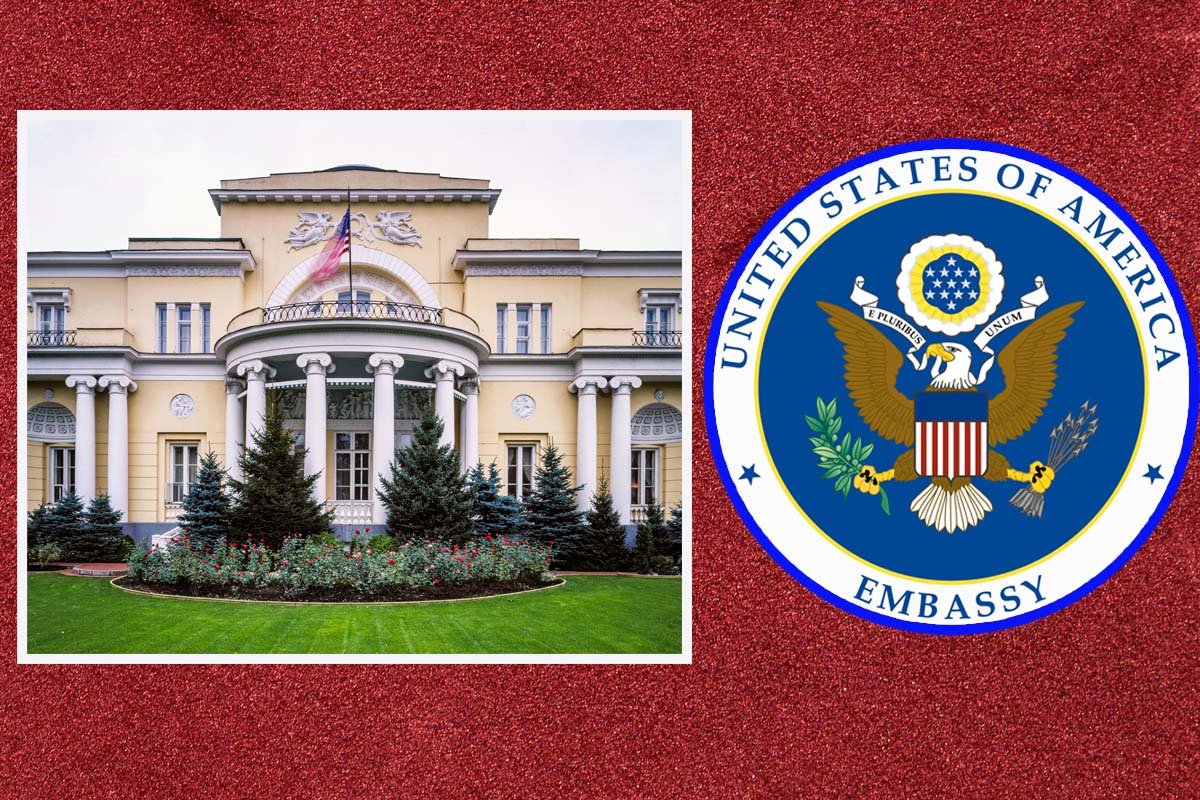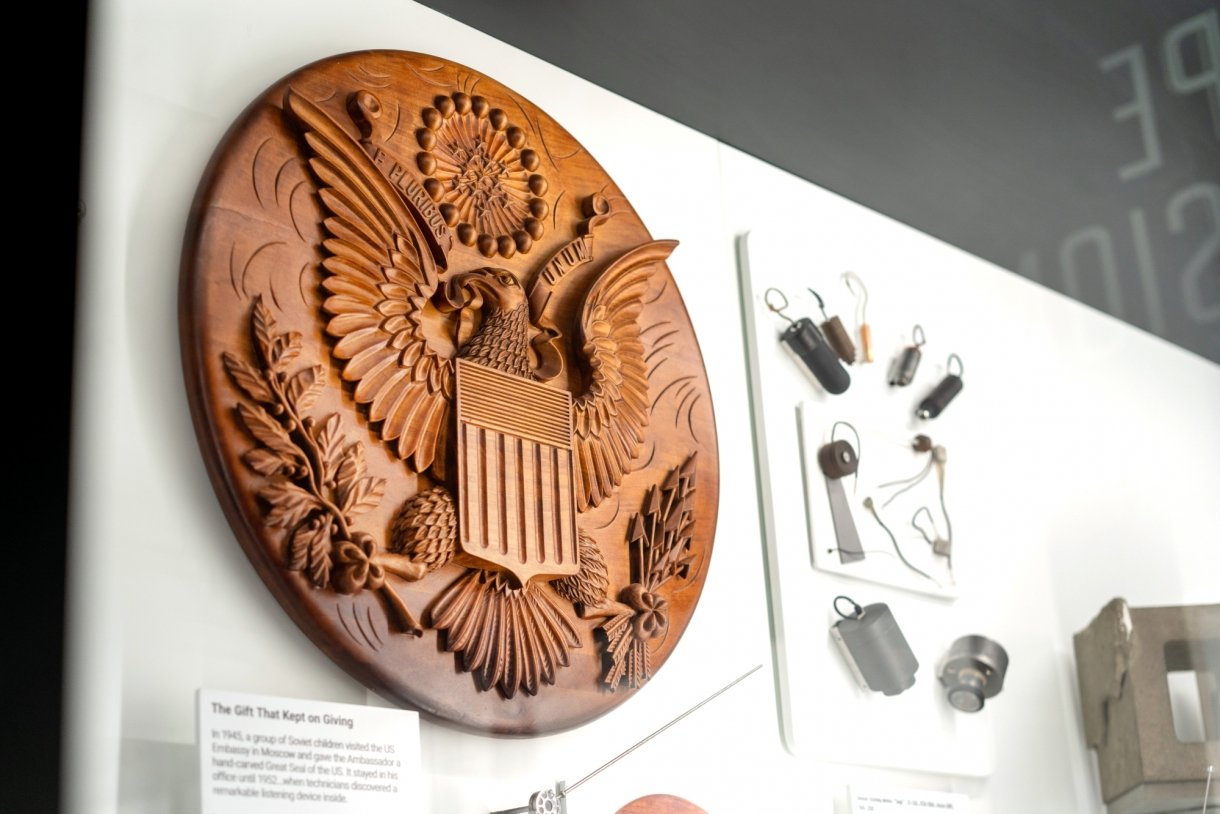The Great Seal Bug: How a US Ambassador Accidentally Installed a Russian Microphone

The Great Seal Bug — commonly referred to as “The Thing” because of its complex design — provided Soviet intelligence officers with compromising access to secret diplomatic conversations held in the residence of the US ambassador in Moscow until the bug was discovered in 1952. US Department of State photo and image. Composite by Coffee or Die Magazine.
In the closing weeks of World War II, the Vladimir Lenin All-Union Pioneer Organization, named after the infamous first head of the Soviet Union, presented US ambassador W. Averell Harriman with a “gift of friendship.”
However, this “gift,” which appeared to celebrate the wartime alliance between the United States and the USSR, was actually one of the first shots of the coming Cold War.
The gift was a wooden, hand-carved replica of the Great Seal of the United States. Harriman took the gift home, hanging it on a back wall in the library of the Spaso House, the residence of the US ambassador in Moscow. The Spaso House was also where US officials held high-level meetings to discuss important US policy. Security was paramount. But a series of clues eventually emerged showing that, somehow, the Russians were listening in.

According to the Crypto Museum, “a British radio operator had been monitoring Russian air force radio traffic, when he picked up the voice of the British Air Attaché loud and clear, but a survey of the embassy did not reveal any hidden microphones. A similar thing happened to an American interceptor in 1952, when he overheared [sic] a conversation that appeared to come from the ambassador’s residency at Spaso House.”
A technical surveillance sweep of the residency in 1952 finally zeroed in on the plaque, revealing an ingenious passive covert listening device inside. Unlike most microphones or recording devices, the so-called Great Seal Bug lacked a power source. Instead, it was activated through an electromagnetic radio signal beamed in from outside.
“The Thing is a so-called resonant cavity microphone, consisting of a resonant cavity, combined with a condenser microphone,” according to the Crypto Museum. “The device consists of a copper cylinder with a highly polished silver-plated interior, that acts as a high-Q resonant cavity of the reentrant type. At the center is an adjustable mushroom-shaped disc with a flat surface, which acts as a capacitor in combination with a very thin 75µm membrane that closes the open end. An antenna enters the cavity through an insulated hole in the side of the cylinder and is capacitively coupled.”

The complex design gave the device a limitless lifespan, and it seemed to be undetectable except while activated. The Truman administration kept the device’s discovery a closely guarded secret, and it stayed that way until a far more serious confrontation between the US and the Soviets: the 1960 shootdown of an American U-2 spy plane over Russia.
The United Nations Security Council convened to address the Soviet complaints of the US spy flights. On May 26, 1960, after three days of accusations against the US for espionage tactics, US Ambassador to the United Nations Henry Cabot Lodge Jr. held up the seal for the full council to see — an example, he said, that the Soviets had their own long history of spying.
Calling the bugged seal “a concrete example of Soviet espionage,” Lodge described how it had been “presented by Russians to the United States ambassador in the Soviet Union, and it was hung up in his office right in back of the ambassador’s desk. Then a clandestine listening device was discovered inside this replica of the Great Seal of the United States. At the time of the discovery, there was a plaster of paris ring around the edge of the seal which joined the front and the back making it look like a solid piece of wood. It was not until the detection of the clandestine device that this ring was broken off, revealing that the seal was made in two pieces and designed to conceal technical listening equipment.
“This record makes it particularly unsuitable for the Soviet Union to adopt a holier than thou attitude and to criticize others.”
Read Next:

Matt Fratus is a history staff writer for Coffee or Die. He prides himself on uncovering the most fascinating tales of history by sharing them through any means of engaging storytelling. He writes for his micro-blog @LateNightHistory on Instagram, where he shares the story behind the image. He is also the host of the Late Night History podcast. When not writing about history, Matt enjoys volunteering for One More Wave and rooting for Boston sports teams.
BRCC and Bad Moon Print Press team up for an exclusive, limited-edition T-shirt design!
BRCC partners with Team Room Design for an exclusive T-shirt release!
Thirty Seconds Out has partnered with BRCC for an exclusive shirt design invoking the God of Winter.
Lucas O'Hara of Grizzly Forge has teamed up with BRCC for a badass, exclusive Shirt Club T-shirt design featuring his most popular knife and tiomahawk.
Coffee or Die sits down with one of the graphic designers behind Black Rifle Coffee's signature look and vibe.
Biden will award the Medal of Honor to a Vietnam War Army helicopter pilot who risked his life to save a reconnaissance team from almost certain death.
Ever wonder how much Jack Mandaville would f*ck sh*t up if he went back in time? The American Revolution didn't even see him coming.
A nearly 200-year-old West Point time capsule that at first appeared to yield little more than dust contains hidden treasure, the US Military Academy said.












